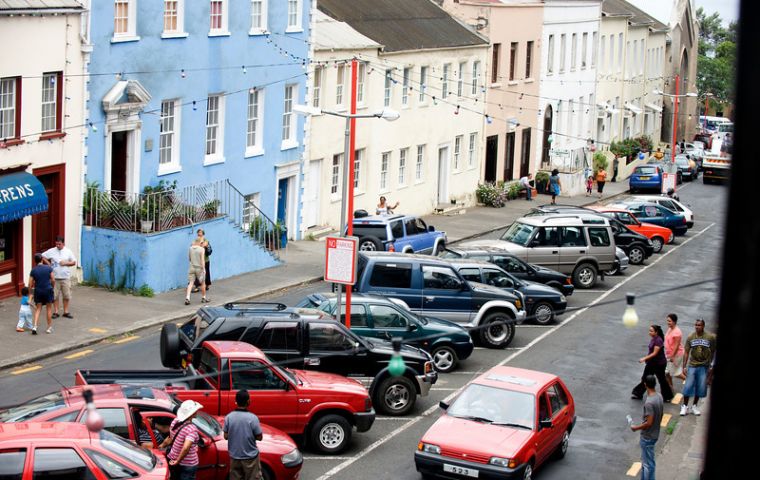MercoPress. South Atlantic News Agency
Namibia will supply cement for St Helena 300m dollars airport in South Atlantic
 Jamestown the quiet capital of St Helena
Jamestown the quiet capital of St Helena Namibian cement company Ohorongo cement has secured a three-year contract with construction firm Basil Read for the supply of cement for the building of a new airport on the British overseas territory of St Helena in the South Atlantic Ocean, over 1900km from the Namibian coast.
In November 2011 Basil Read secured a 300 million dollars contract from the British Government to build an airport on the island. The island, one of the most remote locations on the planet, is currently supplied by boat.
Ohorongo said that it was 'very excited' about supplying cement to the project. The company will export the cement in 1.5t bulk-bags packed into 20ft containers by means of a 3.000t vessel. It will operate between St Helena and Walvis Bay, Namibia on a three week cycle.
The airport project is expected to take over 48 months and will include paved runways, a rock-fill, reinforced concrete culvert, a terminal and combined building, air-traffic control tower, a 14km long airport road and all related logistics. The island measures only 16km by 8km, is considered one of the world’s most remote locations.
The idea of an airport on St Helena in the middle of the South Atlantic was initially proposed in 1999 to replace the ageing and main sea link RMS St Helena. She Is vital to the island and as well as bringing mail and vital supplies, it can also carry a small number of tourists, estimated at 1000 per year. However the journey takes about 14 days from the UK and about 7 from Cape Town in South Africa.
The airport location site on the East of the island near Prosperous Bay Plain is considered the only piece of land suitable on St Helena for a runway. It is believed that the runway will be 2250 meters in length - long enough for planes as large as the Airbus A320 and Boeing 737-800 to land, both of which are capable of carrying 200 passengers.
With the construction of the airport, St Helena will become a strategic point in mid ocean with connections to South America, Africa and South Atlantic territories
St Helena is most widely known for housing Napoleon Bonaparte when he was exiled there in 1815 by the British. Because of this, 2 places on the Island are now owned by the French: Longwood house where Napoleon lived during his stay and Sane valley where he was buried (although his remains were taken back to France is 1840).




Top Comments
Disclaimer & comment rules-

-

-

Read all commentsAirport at last: great news. It will certainly improve communication across the South Atlantic
Aug 02nd, 2012 - 03:29 pm 0Just need a big (100 square mile) floating island somewhere between St Helena and the Falklands. Possibly mobile. Possibly submersible. Runways. Fuel supplies. Watertight hangars.
Aug 02nd, 2012 - 04:19 pm 02 Conqueror
Aug 02nd, 2012 - 07:23 pm 0You just reminded me, the year I was born, it was actaully reported on my birthday ( and no, I'm not going to tell you ) there was a report in “The Times” about the british government seriously considering the idea of a couple of “Floating airports” in the Thames estuary to help ease the pressure on Heathrow and Gatwick.
It was a great idea right until someone calculated that when a 747 landed on it, the whole thing would either:-
flip right over
or
tilt so much that the airplane would be trying to land uphill.
Commenting for this story is now closed.
If you have a Facebook account, become a fan and comment on our Facebook Page!